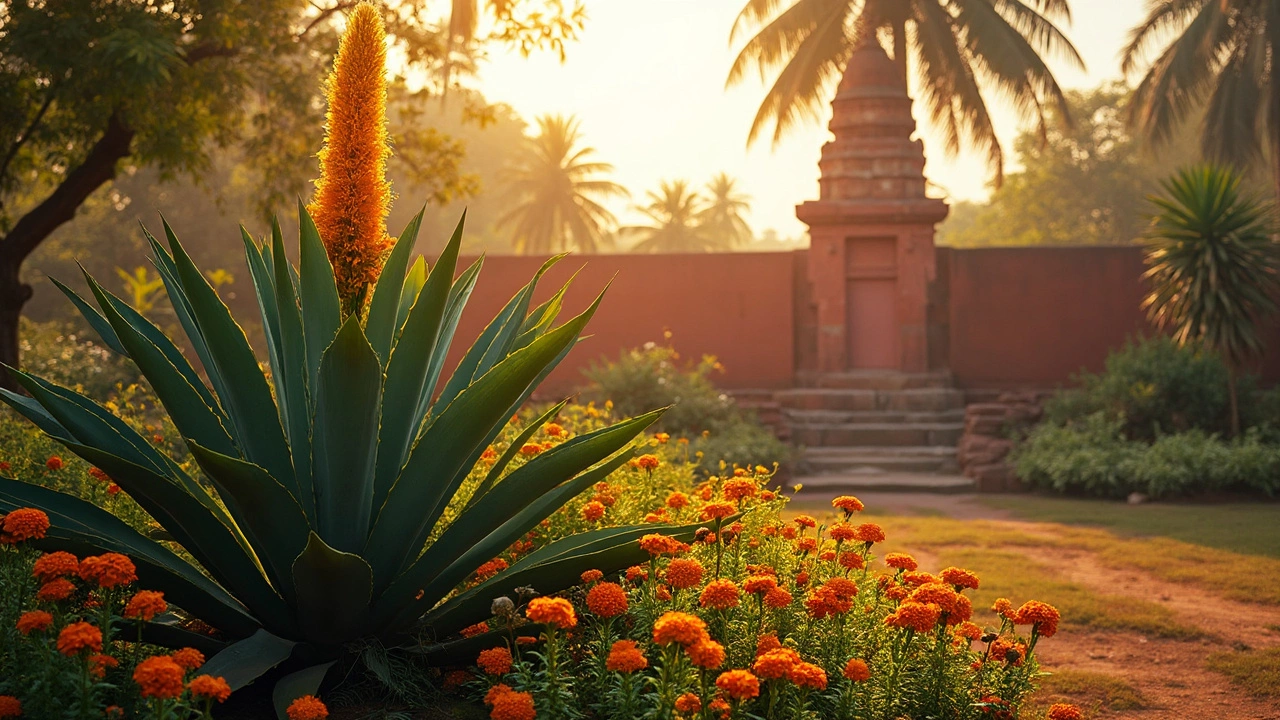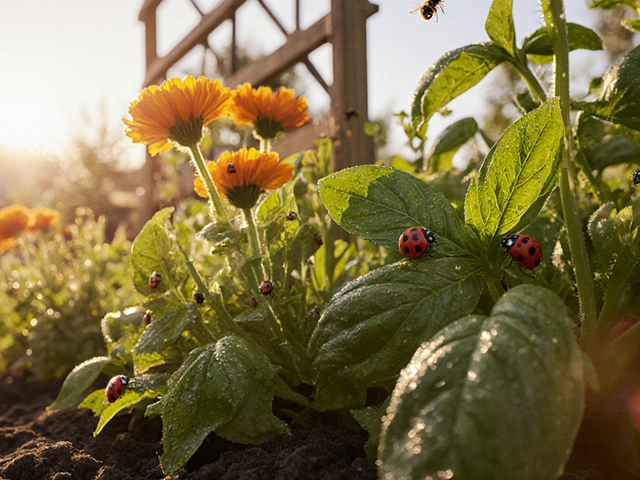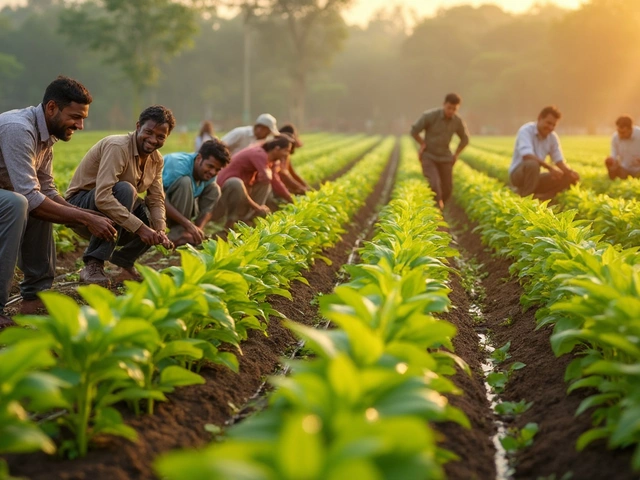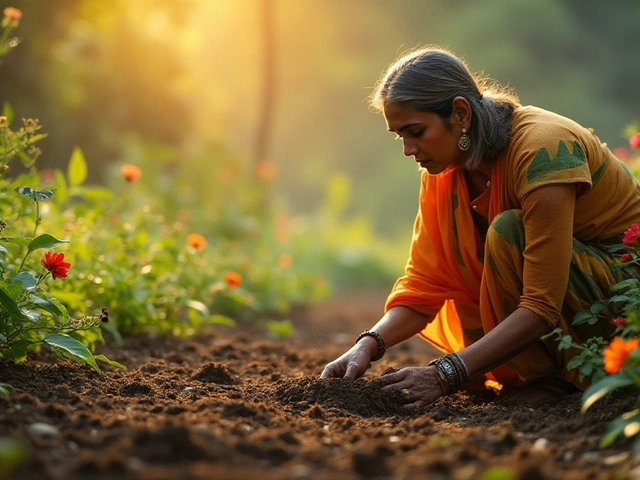So, there’s this plant that just loves to keep you waiting. It's called the century plant—Agave americana if you want to sound fancy at a nursery. Word is, people believe it takes 100 years to bloom. Truth is, it’s a bit more generous, usually flowering somewhere between 10 and 30 years. Still, that’s a solid chunk of your life spent staring at spiky leaves, hoping for something spectacular.
If you’re into gardening in India and you want the bragging rights for having a ‘once-in-a-lifetime’ bloom, this plant’s got you covered. The bloom itself? Massive and dramatic. We’re talking a flower stalk shooting up to 30 feet, covered in yellow or greenish blooms. Then, as quickly as the show starts, it’s over—the entire plant dies right after.
Patience isn’t just a virtue here, it’s a requirement. Think about where you’d plant one, since you don’t want to move it—those leaves are sharp and stubborn. And if you have a dog like Max, trust me: keep him away from those spines. They’ve sent more than one gardening enthusiast to the first-aid kit.
- The Myth and Reality of the Century Plant
- Meet the Agave Americana: India’s 100-Year Wonder
- How and When Does the Century Plant Bloom?
- Spotting a Bloom: Stories from Indian Gardeners
- Growing Tips for Patience-Tested Gardeners
- Cool Facts: Wildlife, Culture, and Unexpected Surprises
The Myth and Reality of the Century Plant
Everyone loves a wild gardening story, and nothing gets repeated more than the so-called 'hundred-year bloom' mystery of the century plant. People swear the Agave americana only flowers once in a century, which sounds epic—except it’s not really true. In reality, the plant usually blooms in just 10 to 30 years, depending on where you plant it and the climate. That’s still a serious wait, but nowhere near the length of a human lifetime.
This myth probably started because the plant’s appearance doesn’t change much year after year. It just sits there, all spiky and dramatic, then out of nowhere throws up a crazy tall flower spike—kind of like that quiet guy at work suddenly doing karaoke. After it blooms, the main plant dies, but usually leaves behind a bunch of baby pups at the base. That’s nature’s way of making sure your flower gardening in India doesn’t end with one big show.
Let’s get real about this plant’s bloom cycle, because there’s a lot of confusion:
- Bloom Time: Between 10-30 years in Indian climates. Drier areas = slower bloom.
- Height of Flower Stalk: Can shoot up to 30 feet (about three floors up!).
- Lifespan: The plant dies after flowering, but it leaves offsets (small new plants) so you won’t have an empty spot for long.
If you want the real drama, check out how tall these things get:
| Plant Age at Bloom | Stalk Height |
|---|---|
| 10-15 years | 15-20 ft |
| 16-25 years | 20-30 ft |
That 'century' part is just a clever marketing spin that’s stuck for decades. It’s still one of the rarest blooming events you’ll see in your garden—but at least now you know you won’t have to live to 120 to see it happen.
Meet the Agave Americana: India’s 100-Year Wonder
The century plant is sort of a rockstar in the world of unusual plants. Formally called Agave americana, it looks like it belongs in a Sergio Leone western, but you’ll find it growing all over India too. It’s not a cactus, but it sure acts tough. Its spiky blue-green leaves grow in circular arrangements, reaching up to two meters long. The plant practically screams, “Don’t mess with me,” especially when it comes to pets or curious kids.
This thick-leaved beauty isn’t actually waiting 100 years to bloom, but it sure feels that way. Depending on where you live in India, the Agave americana typically flowers after 10-30 years, though it can stretch to 40 if it’s feeling especially stubborn. When it decides to bloom, it sends up a flower stalk so tall it can rival a coconut tree—up to 10 meters high!
It’s widely used in Indian gardens for a really simple reason: the thing can handle neglect. It won’t whine if you forget to water it now and then. Drought, blazing sun, poor soil—the century plant just shrugs it off. For anyone new to flower gardening in India, having an Agave means you’ll at least have one plant that won’t give you guilt trips.
Just to give you a sense of what you’d be dealing with, check this out:
| Feature | Details |
|---|---|
| Time to Bloom | 10-30 years (rarely up to 40) |
| Flower Stalk Height | Up to 10 meters (30 feet) |
| Common Uses | Ornamental, hedges, soil conservation |
| Native Origin | Mexico, naturalized in India |
| Water Needs | Low |
And after its one big show, the original plant dies, but it typically leaves behind a bunch of “pups”—small plants you can dig up and replant. So, while you might spend years waiting for that one bloom, you’re basically set up for a whole new crop of century plants every generation. If you don’t want your whole garden overrun, it helps to cut out those pups early.
How and When Does the Century Plant Bloom?
If you're hoping for a quick payoff, the century plant might test your patience. The name says “century,” but in reality, most Agave americana bloom somewhere between 10 and 30 years—never 100. They grow steadily, storing energy in thick, spiky leaves. When the plant is finally mature and has built up enough reserves, it begins an epic final show.
The blooming process kicks off with a giant flower stalk shooting up from the center of the plant. This stalk can reach up to 9 meters (close to 30 feet) tall. The shape reminds some people of an oversized asparagus spear, which is spot on. Buds appear along the stalk and, over a few weeks, open into clusters of yellow-green flowers. In India’s hot, dry climates, blooming usually happens in May to July, though some regions see it a bit later if the weather is cooler.
Here’s what usually has to happen before you spot blooms in your flower gardening india patch:
- The plant must be mature (at least 10 years old—sometimes up to 30).
- It needs full sun and well-drained soil. Waterlogged roots will stall blooming or kill the plant.
- Warm, dry spells tend to trigger blooming after good growth years.
- You’ll notice the leaves start to droop or curl just before the stalk appears.
Once flowering is finished, the main plant dies, but don’t panic—‘pups’ or baby plants often pop up around the rosette, ready to start the slow process all over again. Want to see how long you might have to wait? Here's an at-a-glance look:
| Region | Typical Bloom Time | Bloom Month (India) |
|---|---|---|
| Northern India | 12-20 years | May-July |
| Southern India | 10-18 years | April-June |
| Western India | 15-25 years | June-August |
If someone tells you they watched their century plant bloom for a whole season, they're not exaggerating—the display can last a couple of months. But once the party is over, that’s it for the original plant. So, if you’re planning on growing this legend, think long-term and enjoy the suspense.
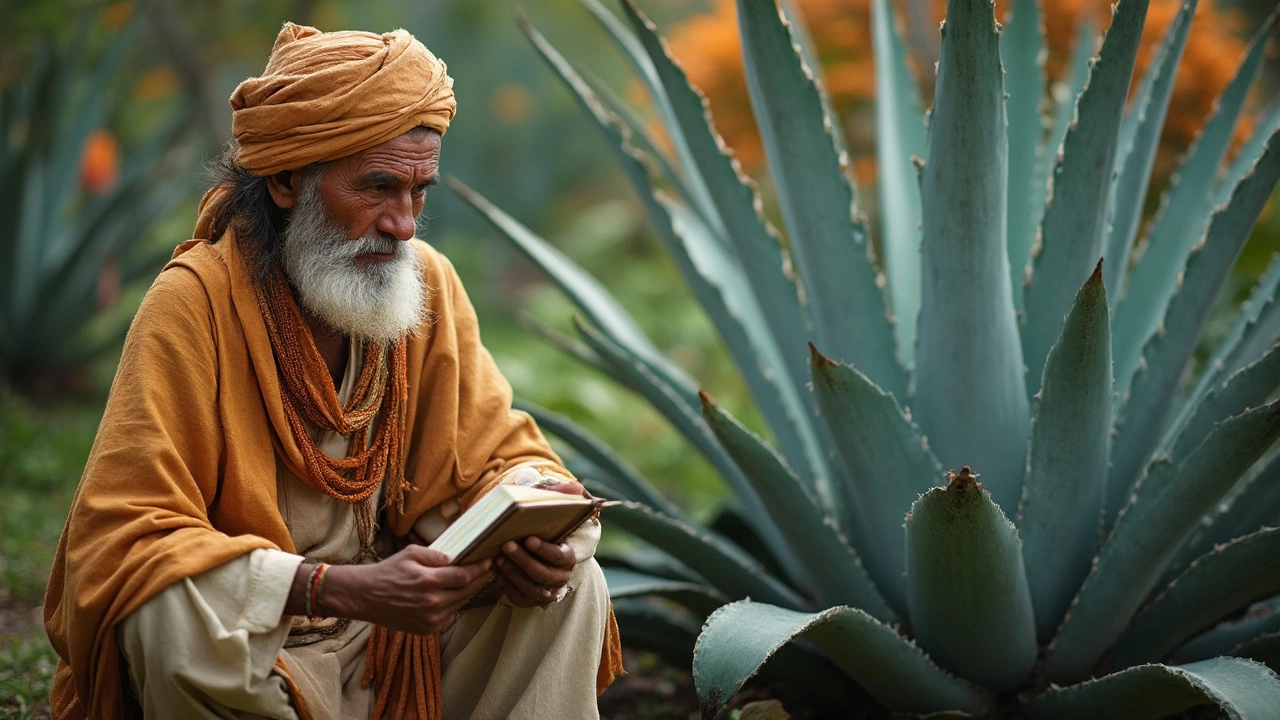
Spotting a Bloom: Stories from Indian Gardeners
It's one thing to read about the century plant and another to actually spot one blooming in an Indian garden. When it happens, people don’t just notice—they talk about it for years. There have been some famous blooms in places like Pune, Bengaluru, and Delhi over the past decade. People gather, snap photos, and watch the massive flower stalk stretch higher every day, amazed at how quickly it grows after years of waiting.
Most gardeners agree: the moment you see that flower spike poking up, you’ll want to invite your neighbors over. For one family in Hyderabad, the stalk grew almost six inches a day; within a month, it towered above their roof. Garden clubs love to pass around these stories, with friends sharing tips on how to keep the area safe—mostly to keep kids and pets (like Max) away from the leaves, which can get sharp as knives.
Some folks time their garden visits just to catch a glimpse, treating it like a festival. In fact, when a century plant put on its flower show in a Mumbai park in 2021, the local paper estimated nearly 300 people came by in a single weekend just for photos. Some Indian gardeners even keep bloom diaries, recording the stalk’s progress, how long it lasts, and how many blooms they count till the plant bows out for good.
If you want to spot one yourself, here’s what folks say you should watch for:
- Look for thickening in the center of the plant—like a massive asparagus stalk rising up
- Growth can skyrocket—some shoots gain nearly a foot daily
- The blooms tend to open at the very peak, spreading out in clusters
- Blooms usually last for a couple of weeks before fading
Not every gardener will see a bloom in their lifetime, but in flower gardening india, the buzz when one appears is bigger than Diwali fireworks. If you ever hear about a rare blooming event nearby, go see it. You’ll probably meet half the neighborhood while you’re there.
Growing Tips for Patience-Tested Gardeners
Raising a century plant (Agave americana) is not exactly a quick-reward project, but it’s easier than most folks think. These giants are tough, especially if you’re planting them in a hot, dry part of India. They don’t care much about rich soil—a spot with good drainage works. Too much rain or soggy dirt is a no-go. If you’re planting in a pot, just use sandy or cactus potting mix.
Watering? Less is better. Soak it well, then wait until the soil is totally dry before watering again. Overwatering is the quickest way to kill the plant. I’ve even heard from Mr. Anil Bhatia, a longtime Bangalore gardener, who said,
"The less I fuss over my agave, the happier it looks. Honestly, it’s the laziest success in my yard."
Sunlight is non-negotiable. These plants love direct sun, at least six hours every day. Put them somewhere wide open—they’ll spread out those big leaves and need elbow room. If you squeeze them in with other plants, those sharp spines will win every time, trust me.
Here’s a quick checklist to keep your century plant happy in India:
- Pick a sunny spot with space for the plant to sprawl.
- Use well-draining soil or a cactus mix.
- Water deeply but only after everything is bone dry.
- No fertilizer is really needed. If you do want to feed it, a diluted cactus feed once a year is fine.
- Protect pets and kids—those leaf-tips are like tiny knives.
If you’re tracking growth, check this out. On average, in Indian climates, agave leaves grow 3-5 centimeters each year, with that monster flower spike sometimes rocketing up a foot per day when it’s go-time. It’s not a race, but when it blooms, things get wild fast!
| Condition | Ideal Level |
|---|---|
| Sunlight | 6-8 hours daily |
| Water | Once soil is fully dry |
| Soil Type | Sandy, very well-drained |
Growing the century plant takes patience, but if you’re in for the long game, you’ll end up with a rare sight right in your yard. Just keep Max and anyone barefoot at a safe distance!
Cool Facts: Wildlife, Culture, and Unexpected Surprises
The century plant isn’t just cool because it makes you wait forever to see it bloom. There’s a bunch of weird and fascinating stuff that comes with having one in your garden, especially in India.
First, let’s talk wildlife. When it finally decides to put on a show, the blooming stalk becomes a magnet for all sorts of creatures. You’ll see bees, butterflies, and even bats hovering around those flowers for the sweet nectar. In some parts of southern India, sunbirds love to swoop in daily when these giants are blooming. That’s a win for pollinators and your camera reel.
Culturally, agaves aren’t just for show. In parts of rural India, people use the tough fibers from Agave americana leaves to make strong ropes. These ropes are used for tying cattle or bundling crops. The plant’s juice, though, is a no-go—agave sap can irritate the skin, so gloves are a must when handling it. People in Mexico make tequila with a relative of this plant, but the variety you see in Indian gardens isn’t for drinking. Still, it’s got a cool backstory.
Now, here’s a stat that surprises most folks: The blooming stalk can shoot up almost overnight, sometimes growing 10 to 15 cm (about 4–6 inches) per day in the peak of the bloom. Imagine waking up and thinking the plant grew a foot while you slept—it happens.
| Cool Fact | Did You Know? |
|---|---|
| Bloom height | Up to 9 meters (30 feet) |
| Flowering age | Usually 10–30 years |
| Main pollinators | Bats, bees, butterflies, sunbirds |
| Uses | Rope, fencing, ornamental landscaping |
Another unexpected thing: after blooming, the mother plant dies, but it leaves behind a bunch of baby plants (called pups) around its base. These can be dug up and replanted. So you get a bittersweet ending—one plant dies, but many more pop up right after.
Oh, and if you’ve got pets like Max, keep them clear of the dying stalks and spiky pups. Those things don’t mess around—agave tips can puncture skin, and nobody wants an emergency trip to the vet over a gardening trophy.
